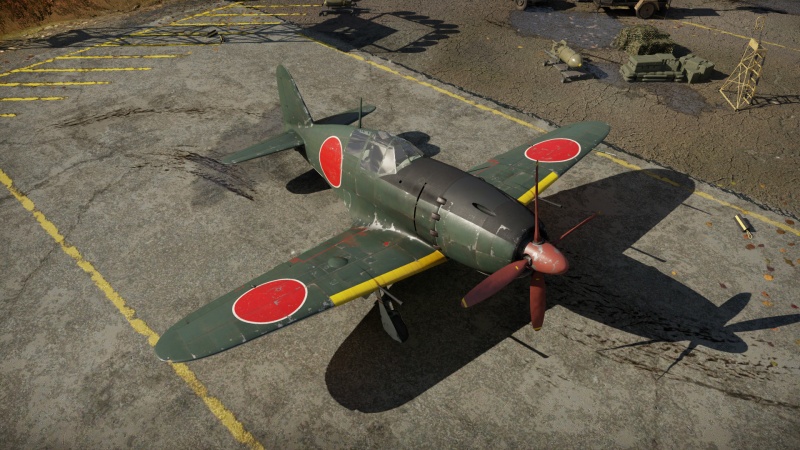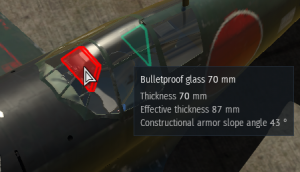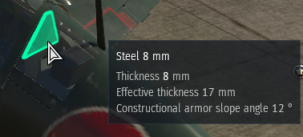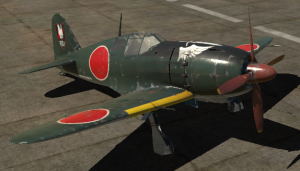J2M2
| This page is about the Japanese fighter J2M2. For other uses, see J2M (Family). |
Contents
Description
The J2M2 Raiden is a rank III Japanese fighter with a battle rating of 5.3 (AB), 5.0 (RB), and 3.7 (SB). It was introduced in Update 1.49 "Weapons of Victory".
General info
Flight performance
The J2M2 Raiden is an odd duck of an interceptor, featuring the weird combination of high climb rate but poor diving characteristics. It's main go-to is somewhat like the Bf-109 and Yak series - vertically looping opponents to bleed their speed and then swooping down or coming up behind them to punish. The guns are frustrating to use due to their below-average muzzle velocity, small ammo supply, and atrociously low rate of fire on the cannons.
The aircraft shares the same characteristics as the future J2M3 and M5 and can be a demo of what is there to come in the Japanese tree. The other models do not have particularly higher engine performance, and are only slightly faster with slightly better firepower, their main advantage being vastly more ammo to spray with.
| Characteristics | Max Speed (km/h at 5,500 m) |
Max altitude (metres) |
Turn time (seconds) |
Rate of climb (metres/second) |
Take-off run (metres) | |||
|---|---|---|---|---|---|---|---|---|
| AB | RB | AB | RB | AB | RB | |||
| Stock | 569 | 551 | 11500 | 19.7 | 20.4 | 16 | 16 | 300 |
| Upgraded | 626 | 596 | 18.8 | 19.0 | 28.3 | 21.2 | ||
Details
| Features | ||||
|---|---|---|---|---|
| Combat flaps | Take-off flaps | Landing flaps | Air brakes | Arrestor gear |
| ✓ | ✓ | ✓ | X | X |
| Limits | ||||||
|---|---|---|---|---|---|---|
| Wings (km/h) | Gear (km/h) | Flaps (km/h) | Max Static G | |||
| Combat | Take-off | Landing | + | - | ||
| 0 | 350 | 488 | 454 | 280 | ~13 | ~10 |
| Optimal velocities (km/h) | |||
|---|---|---|---|
| Ailerons | Rudder | Elevators | Radiator |
| < 430 | < 460 | < 400 | > 324 |
Survivability and armour
Unlike other Japanese fighters, the J2M2 has some decent armour. There is a 70 mm bulletproof glass plate in front of the pilot. There is also a tiny triangular section of steel that is 8 mm behind the pilots head. Another thing the J2M2 has that other Japanese planes don't have near rank 3, is self-sealing fuel tanks. There is however no armour around the engine so the engine is very prone to bullets striking and damaging it.
Modifications and economy
Armaments
Offensive armament
The J2M2 is armed with:
- 2 x 20 mm Type 99 Model 2 cannons, wing-mounted (100 rpg = 200 total)
- 2 x 7.7 mm Type 97 navy machine guns, nose-mounted (550 rpg = 1,100 total)
The two 7.7 mm machine guns are mounted in the cowling of the aircraft serve as good backups if the cannons run dry, or if there is a need to poke a fleeing enemy into a maneuver. The cannons are decent, but the best belts are by far Stealth. The HEF-I and HEF-T rounds have quite low TNT equivalent amounts, while the HEF without tracer has nearly double that amount of explosive. Due to the spotty nature of the guns, Stealth helps mainly by allowing you to surprise opponents more often, as well as having the most HEF by far.
Suspended armament
The J2M2 can be outfitted with the following ordnance:
- Without load
- 2 x 60 kg Navy Type 97 Number 6 bombs (120 kg total)
The two 60 kg bombs are basically worthless. Do not take them.
Usage in battles
In the start of a match, you'll want to use your best advantage, climbing. The J2M2 has an incredible rate of climb for its BR. This will almost always guarantee you an altitude advantage, and from there, you should pick out your targets one-by-one. The J2M2 does not have the best offensive guns so make sure to never head-on. If you are diving on an opponent and they are trying to head-on, break off and do a spiral climb. Your opponent (if he's greedy enough) will stay on you and lose all of his energy. Once you see him about to go into a stall, quickly dive down to him and shoot him down, but do not go too fast as your controls lock up badly above 550kph. Another advantage of the J2M2 is the top speed. The J2M2 can go very fast for its BR and you should use it to your advantage.
Manual Engine Control
| MEC elements | ||||||
|---|---|---|---|---|---|---|
| Mixer | Pitch | Radiator | Supercharger | Turbocharger | ||
| Oil | Water | Type | ||||
| Controllable | Controllable Not auto controlled |
Controllable Not auto controlled |
Controllable Not auto controlled |
Separate | Controllable 2 gears |
Not controllable |
Pros and cons
Pros:
- Excellent climb rate (21.2 m/s spaded)
- Excellent top speed (592 km/h or 370 mph)
- Easily outperforms other allied aircraft it usually faces
- Out turn most allied planes except for the Spitfire
- Small size
- Does not bleed energy like the Zero
- More ammo for the 20 mm than the early Zero models
- Has armour and self-sealing fuel tanks
Cons:
- Awful high-speed diving characteristics
- Still very low ammo supply on the cannons of just 100 rounds per gun
- Low muzzle velocity makes the cannons hard to aim
- Low fire rate means you do not kill quickly despite surprisingly good TNT filler per HEF bullet.
- Slower than US planes
- 7.7 mm machine guns are quite ineffective at 4.3, lowering your combat capability once cannon ammo runs out
History
Development
During the China Incident (Sino-Japanese war) the Navy had sustained some damage from Chinese bomber groups as they didn't have any dedicated interceptors at the time, for this reason the Navy put out multiple specifications for planes to deal with threats which the Chinese made clear to the Navy. For bombers specifically they specified for a strictly local-defense interceptor known as the 14-Shi Interceptor.
The designer behind the A6M, Jiro Horikoshi and his team started development on this specification. But due the harsh unrealistic specifications for mainly engine output required for the team to use a strong engine which wasn't available yet and with the oversized engine required for the task resulted in a sleek but stubby plane.
After the initial J2M1 prototypes outfitted with the 1,044 kW Mitsubishi MK4C Kasei 13 14-cylinder air-cooled radial engine and didn't come near the specification requirements, engine vibrations coming from the cooling system and a troublesome undercarriage design held it back from being used as a production model.
The J2M2 Model 11 was outfitted with 1,379 kW Mitsubishi MK4R-A Kasei 23a 14-cylinder radial engine which somewhat overcame the teething problems but still didn't reach the requirements, overburdened with engine problems and electrical malfunctions in the landing gear remained.
Mitsubishi wanted to make the best of it and get out the J2Ms into combat service before it was officially adopted in the Navy. Engine problems and performance were only further resolved in further modifications.
Combat History
The first few produced J2M2s were delivered to the development units in December 1942 but the troublesome amount of engine problems still held it back from mass production. Troubleshooting almost took a year and the first batch of the serial built J2M2 Model 11 could be delivered to 381st Kōkūtai in December of 1943.
Furthermore, the J2M2 saw limited action in the Philippines, although it was largely ineffective due to the limited initial production batch and design flaws.
Media
- Skins
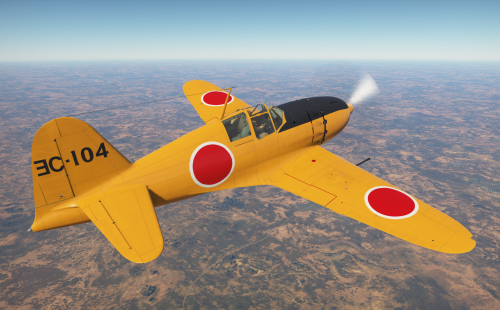
- Images
- Videos
See also
- Mitsubishi J2M3 (following model)
External links
| Mitsubishi Company (三菱商会) | |
|---|---|
| Fighters | A5M4 · Hagiri's A5M4 |
| A6M2 mod. 11 · A6M2 · A6M3 · A6M3 mod. 22 · A6M3 mod. 22Ko · A6M5 · A6M5 Ko · A6M5 otsu · A6M5 Hei · A6M6c | |
| A7M1 (NK9H) · A7M2 | |
| J2M2 · J2M3 · J2M4 Kai · J2M5 · J2M5 (30 mm) | |
| Hydroplanes | F1M2 |
| Interceptors | Ki-83 · Ki-109 |
| Bombers | G4M1 |
| Ki-21-Ia · Ki-21-I hei · Ki-67-I Ko · Ki-67-I otsu | |
| Jet Fighters | Ki-200 |
| Captured | ▃A6M2 · ␗A6M2 |
| See also | Mitsubishi Heavy Industries, Ltd. (Post-War) |
| Japan fighters | |
|---|---|
| Navy | |
| Carrier-based fighter | |
| A5M | A5M4 · Hagiri's A5M4 |
| A6M | A6M2 mod. 11 · A6M2 · A6M3 · A6M3 mod. 22 · A6M3 mod. 22Ko · A6M5 · A6M5 Ko · A6M5 otsu · A6M5 Hei · A6M6c |
| A7He | A7He1* |
| A7M | A7M1 (NK9H) · A7M2 |
| Land-based Fighter | |
| J2M | J2M2 · J2M3 · J2M4 Kai · J2M5 · J2M5 (30 mm) |
| J6K | J6K1 |
| J7W | J7W1 |
| N1K-J | N1K1-Ja · N1K2-J · N1K2-Ja |
| Fighter seaplane | |
| N1K | N1K1 |
| A6M-N | A6M2-N |
| Army | |
| Ki-10 | Ki-10-I · Ki-10-I C · Ki-10-II · Ki-10-II C |
| Ki-27 | Ki-27 otsu · Ki-27 otsu Tachiarai |
| Ki-43 | Ki-43-I · Ki-43-II · Ki-43-III otsu |
| Ki-44 | Ki-44-I · Ki-44-I 34 · Ki-44-II otsu · Ki-44-II hei |
| Ki-61 | Ki-61-I ko · Ki-61-I otsu · Ki-61-I hei · Tada's Ki-61-I hei · Ki-61-I tei · Ki-61-II Otsu Kai |
| Ki-84 | Ki-84 ko · Ki-84 otsu · Ki-84 hei |
| Ki-87 | Ki-87 |
| Ki-94 | Ki-94-II |
| Ki-100 | Ki-100 · Ki-100-II |
| Other countries | ▅F4U-1A · ▅P-51C-11-NT · ▅Bf 109 E-7 · ▅Fw 190 A-5 |
| *Imported designation of the He 112 (A6M was in development - A7M would take A7 designation after the cancelation of the A7He) | |



